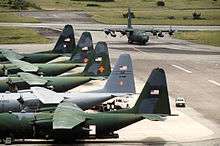Operation Provide Relief
Operation Provide Relief was part of a United Nations-endorsed initiative called the Unified Task Force (UNITAF) to secure and facilitate the delivery of humanitarian relief during the Somali Civil War. This effort was assisted by the UNOSOM I mission, in light of a severe food crisis initiated and exacerbated by ongoing factional fighting. The operation was spearheaded by the United States and other troop-contributing Western nations. However, most of the relief supplies were looted by militants shortly upon arrival. This prompted the UN to pass Resolution 794, which paved the way for the more robust, multinational Operation Restore Hope.
Background

In January 1991, President of Somalia Mohammed Siad Barre, was overthrown by a coalition of rebel groups, including the United Somali Congress, Somali Salvation Democratic Front (SSDF), Somali National Movement (SNM), Somali Patriotic Movement (SPM) and Somali Democratic Movement (SDM). Many of the opposition groups began competing for influence in the ensuing power vacuum. In the south, armed factions led by USC commanders General Mohamed Farah Aidid and Ali Mahdi Mohamed, in particular, clashed as each sought to exert power over the capital Mogadishu.[1]
In June 1991, a ceasefire was nominally agreed upon. The same month, the SNM declared secession in the northwestern part of Somalia. Renaming the region the "Republic of Somaliland", the group's leader Abdirahman Ahmed Ali Tuur was installed as president.
In September 1991, the armistice was breached as fighting broke out again between Mogadishu factions. The armed confrontations continued in the following months and spread throughout the country, with over 20,000 people killed or injured by the end of the year.
These battles led to the destruction of the local agricultural sector, which in turn precipitated a food crisis in large parts of Somalia. The international community in response sent emergency rations. As a consequence, an estimated 300,000 people are believed to have died of starvation between 1991 and 1992.[2] In July 1992, after a ceasefire between the opposing southern-based clan factions, the United Nations sent 50 military observers to supervise the food supply distributions.
Humanitarian operation

Operation Provide Relief began in August 1992, when the White House announced US military transports would support the multinational UN relief effort in Somalia. Ten C-130s and 400 people deployed to the Moi International Airport during Operation Provide Relief, airlifting aid to remote areas in Somalia to reduce reliance on truck convoys. One member of the 86th Supply Squadron deployed with the ground support contingent, USAFE's only contribution to the operation.
The Air Force C-130s delivered 48,000 tons of food and medical supplies in six months to international humanitarian organizations. When this proved inadequate to stop the massive death and displacement, the United Nations Security Council passed Resolution 794 in December 1992 authorizing the use of all necessary means to assure a protected environment for conducting humanitarian operations.[3] In response, the U.S. launched Operation Restore Hope, a major coalition operation to assist and protect relief activities.
After a long and protracted effort, the operation was eventually successful in saving many lives, as well as in de-escalating the high-intensity conflict into low-level, local skirmishes. However, the initiative has been criticized for expanding beyond its original boundaries ("mission creep"). The Washington-based Refugee Policy Group NGO in November 1994 suggests that any assessment of the success of Operation Provide Relief is "so fraught with methodological problems that it is rarely attempted." As such, it asserts that excess mortality had already peaked by the time that the first relief programs in and flights to southern Somalia were set up. The think tank offers a conservative estimate that about 100,000 lives were saved as a result of international assistance, 10,000 of which occurred after U.S. troops arrived in December 1992.[4]
See also
References
- ↑ Library Information and Research Service, The Middle East: Abstracts and index, Volume 2, (Library Information and Research Service: 1999), p.327.
- ↑ "Twentieth Century Atlas – Death Tolls and Casualty Statistics for Wars, Dictatorships and Genocides". Users.erols.com. Retrieved 2011-04-20.
- ↑ United Nations, Security Council resolution 794 (1992), 24 April 1992, para. 3
- ↑ Maren, Michael (2009). The Road to Hell. Simon and Schuster. p. 214. ISBN 1439188416.
Further reading
- Allard, Colonel Kenneth, Somalia Operations: Lessons Learned, National Defense University Press (1995)